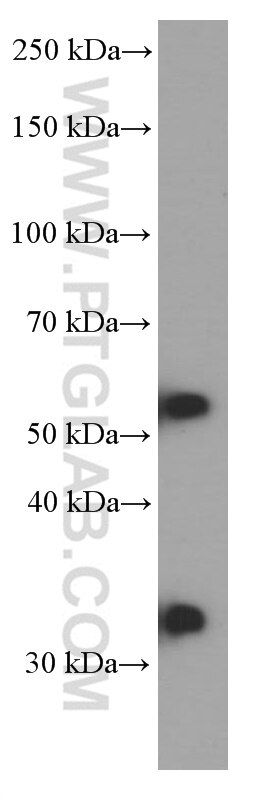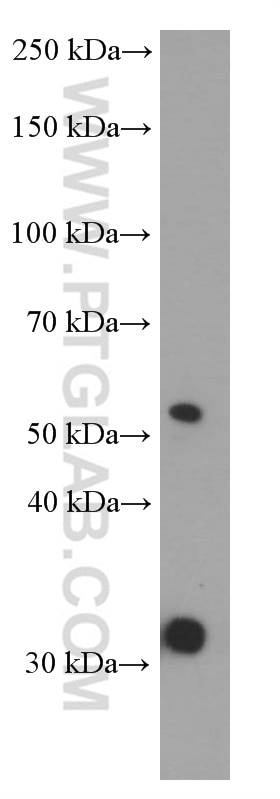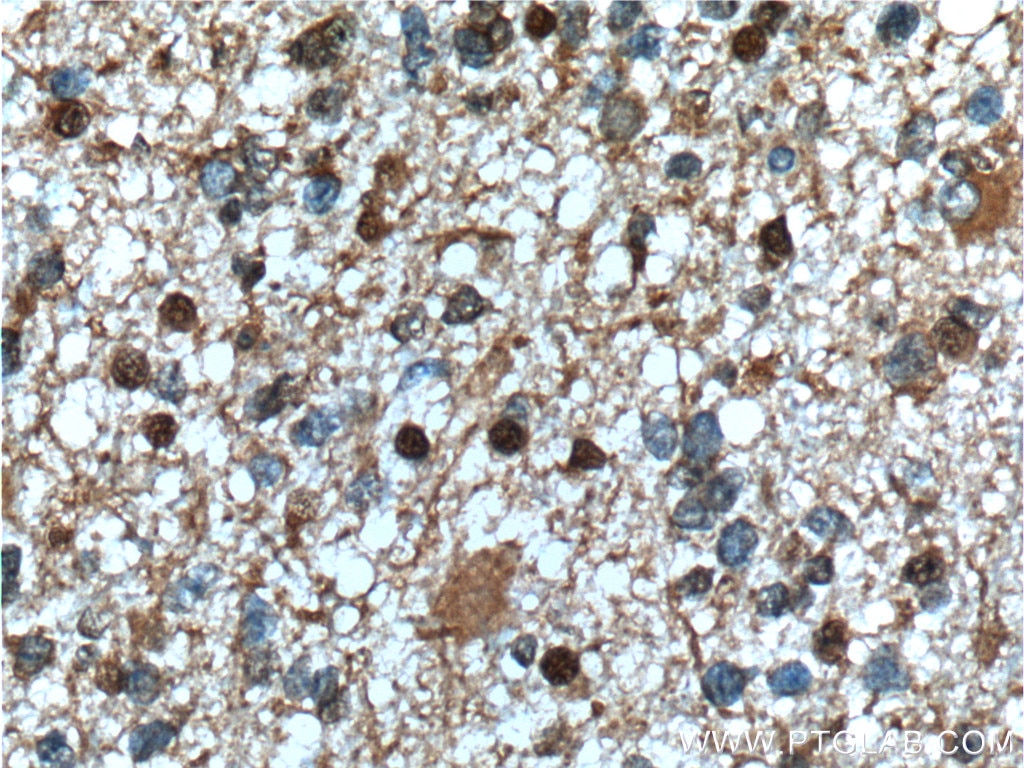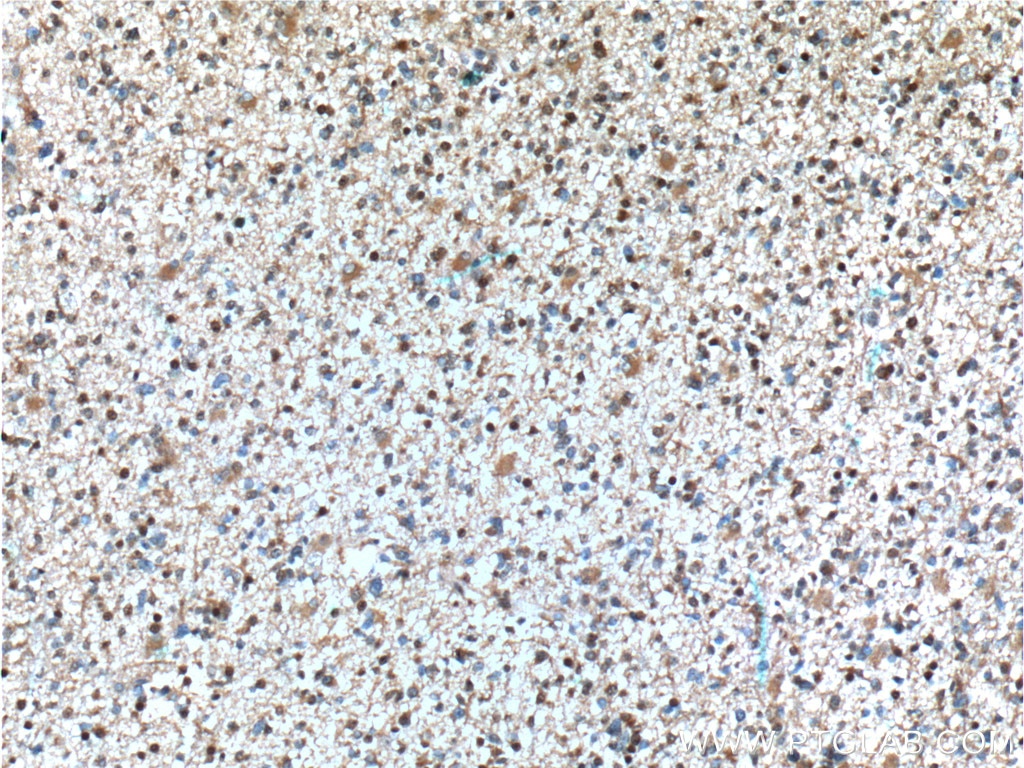Tested Applications
| Positive WB detected in | fetal human brain tissue, HEK-293 cells, Neuro-2a cells |
| Positive IHC detected in | human gliomas tissue Note: suggested antigen retrieval with TE buffer pH 9.0; (*) Alternatively, antigen retrieval may be performed with citrate buffer pH 6.0 |
Recommended dilution
| Application | Dilution |
|---|---|
| Western Blot (WB) | WB : 1:500-1:2000 |
| Immunohistochemistry (IHC) | IHC : 1:50-1:500 |
| It is recommended that this reagent should be titrated in each testing system to obtain optimal results. | |
| Sample-dependent, Check data in validation data gallery. | |
Published Applications
| WB | See 1 publications below |
| IF | See 1 publications below |
| CoIP | See 1 publications below |
Product Information
66341-1-Ig targets PHF10 in WB, IF, IHC, CoIP, ELISA applications and shows reactivity with human, mouse samples.
| Tested Reactivity | human, mouse |
| Cited Reactivity | human, mouse |
| Host / Isotype | Mouse / IgG1 |
| Class | Monoclonal |
| Type | Antibody |
| Immunogen |
CatNo: Ag19096 Product name: Recombinant human PHF10 protein Source: e coli.-derived, PET28a Tag: 6*His Domain: 1-408 aa of BC020954 Sequence: MLQEQVSEYLGVTSFKRKYPERRDLSHKEKLYLRELNVITETQCTLGLTALRSDEVIDLMIKEYPAKHAEYSVILQEKERQRITDHYKEYSQMQQQNTQKVEASKVPEYIKKAAKKAAEFNSNLNRERMEERRAYFDLQTHVIQVPQGKYKVLPTERTKVSSYPVALIPGQFQEYYKRYSPDELRYLPLNTALYEPPLDPELPALDSDGDSDDGEDGRGDEKRKNKGTSDSSSGNVSEGESPPDSQEDSFQGRQKSKDKAATPRKDGPKRSVLSKSVPGYKPKVIPNAICGICLKGKESNKKGKAESLIHCSQCENSGHPSCLDMTMELVSMIKTYPWQCMECKTCIICGQPHHEEEMMFCDMCDRGYHTFCVGLGAIPSGRWICDCCQRAPPTPRKVGRRGKNSKEG Predict reactive species |
| Full Name | PHD finger protein 10 |
| Calculated Molecular Weight | 408 aa, 46 kDa |
| Observed Molecular Weight | 56 kDa, 35 kDa |
| GenBank Accession Number | BC020954 |
| Gene Symbol | PHF10 |
| Gene ID (NCBI) | 55274 |
| RRID | AB_2881721 |
| Conjugate | Unconjugated |
| Form | Liquid |
| Purification Method | Protein G purification |
| UNIPROT ID | Q8WUB8 |
| Storage Buffer | PBS with 0.02% sodium azide and 50% glycerol, pH 7.3. |
| Storage Conditions | Store at -20°C. Stable for one year after shipment. Aliquoting is unnecessary for -20oC storage. 20ul sizes contain 0.1% BSA. |
Background Information
PHF10, also named as BRG1-associated factor 45a, is a 498 amino acid protein, which locate in the nucleus and Belongs to the SAYP family. PHF10 Involve in transcription activity regulation by chromatin remodeling. It Belongs to the neural progenitors-specific chromatin remodeling complex (npBAF complex) and is required for the proliferation of neural progenitors. During neural development a switch from a stem/progenitor to a post-mitotic chromatin remodeling mechanism occurs as neurons exit the cell cycle and become committed to their adult state. The transition from proliferating neural stem/progenitor cells to post-mitotic neurons requires a switch in subunit composition of the npBAF and nBAF complexes. As neural progenitors exit mitosis and differentiate into neurons, npBAF complexes which contain ACTL6A/BAF53A and PHF10/BAF45A, are exchanged for homologous alternative ACTL6B/BAF53B and DPF1/BAF45B or DPF3/BAF45C subunits in neuron-specific complexes (nBAF). The npBAF complex is essential for the self-renewal/proliferative capacity of the multipotent neural stem cells. The nBAF complex along with CREST plays a role regulating the activity of genes essential for dendrite growth. PHF10 exists as several isoform and the calculated molecular weight of each isoform is 42 kDa, 37 kDa, 51 kDa, and 56 kDa.
Protocols
| Product Specific Protocols | |
|---|---|
| IHC protocol for PHF10 antibody 66341-1-Ig | Download protocol |
| WB protocol for PHF10 antibody 66341-1-Ig | Download protocol |
| Standard Protocols | |
|---|---|
| Click here to view our Standard Protocols |
Publications
| Species | Application | Title |
|---|---|---|
Glia DHHC5 facilitates oligodendrocyte development by palmitoylating and activating STAT3. | ||
bioRxiv BRD9-SMAD2/3 orchestrates stemness and tumorigenesis in pancreatic ductal adenocarcinoma | ||
Gastroenterology BRD9-SMAD2/3 orchestrates stemness and tumorigenesis in pancreatic ductal adenocarcinoma |














